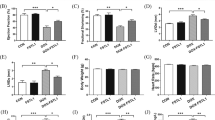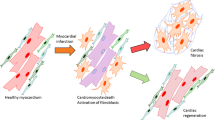Abstract
To address whether adult rat ventricular cardiomyocytes (ARVCs) exposed to oxidant stress die via apoptosis (secondarily by necrosis) or primarily by necrosis, we exposed ARVCs to hydrogen peroxide (H2O2; 0.1–100 μM) for up to 24 h and then compared them with isoproterenol-induced apoptotic and Triton X-induced necrotic controls. Cellular shrinkage preceded plasma membrane disruption, reflected by trypan blue uptake in ARVCs exposed to lower concentrations of H2O2 (<1 μM; an apoptotic pattern), but the order was reversed in cells exposed to higher concentrations of H2O2 (>1 μM; a necrotic pattern). DNA fragmentation, caspase-3 activation, mitochondrial membrane potential preservation, and ATP preservation were all apparent in ARVCs treated with low H2O2 (0.5 μM), but not in those treated with high H2O2 (10 μM). In addition, electron microscopy revealed unique morphology in H2O2-treated ARVCs; i.e., the nuclei had a homogeneous ground glass-like appearance that was never accompanied by chromatin condensation. Apparently, high concentrations of H2O2 caused primary necrosis in ARVCs, whereas low concentrations induced biochemically comparable apoptosis, although the latter did not satisfy the morphological criteria of apoptosis. These findings caution against the use of oxidant stress, H2O2 in particular, as an inducer of apoptosis in ARVCs.
Similar content being viewed by others
References
Tsutsui H (2004) Novel pathophysiological insight and treatment strategies for heart failure: lessons from mice and patients. Circ J 68:1095–1103
Giordano FJ (2005) Oxygen, oxidative stress, hypoxia, and heart failure. J Clin Invest 115:500–508
von Harsdorf R, Li PF, Dietz R (1999) Signaling pathways in reactive oxygen species-induced cardiomyocyte apoptosis. Circulation 99:2934–2941
Kwon SH, Pimentel DR, Remondino A, Sawyer DB, Colucci WS (2003) H2O2 regulates cardiac myocyte phenotype via concentration-dependent activation of distinct kinase pathways. J Mol Cell Cardiol 35:615–621
Taimor G, Lorenz H, Hofstaetter B, Schlüter KD, Piper HM (1999) Induction of necrosis but not apoptosis after anoxia and reoxygenation in isolated adult cardiomyocytes of rat. Cardiovasc Res 41:147–156
Suzuki K, Kostin S, Person V, Elsasser A, Schaper J (2001) Time course of the apoptotic cascade and effects of caspase inhibitors in adult rat ventricular cardiomyocytes. J Mol Cell Cardiol 33: 983–994
Bird SD, Doevendans PA, van Rooijen MA, Brutel de la Riviere A, Hassink RJ, Passier R, Mummery CL (2003) The human adult cardiomyocyte phenotype. Cardiovasc Res 58:423–434
Schaper J, Froede R, Hein S, Buck A, Hashizume H, Speiser B, Friedl A, Bleese N (1991) Impairment of the myocardial ultrastructure and changes of the cytoskeleton in dilated cardiomyopathy. Circulation 83:504–514
Wyllie AH, Kerr JF, Currie AR (1980) Cell death: the significance of apoptosis. Int Rev Cytol 68:251–306
Taatjes DJ, Sobel BE, Budd RC (2008) Morphological and cytochemical determination of cell death by apoptosis. Histochem Cell Biol 129:33–43
Piper HM, Probst I, Schwartz P, Hutter FJ, Spieckermann PG (1982) Culturing of calcium stable adult cardiac myocytes. J Mol Cell Cardiol 14:397–412
Maruyama R, Takemura G, Tohse N, Ohkusa T, Ikeda Y, Tsuchiya K, Minatoguchi S, Matsuzaki M, Fujiwara T, Fujiwara H (2006) Synchronous progression of calcium transient-dependent beating and sarcomere destruction in apoptotic adult cardiomyocytes. Am J Physiol Heart Circ Physiol 290:H1493–H1502
Zaugg M, Xu W, Lucchinetti E, Shafiq SA, Jamali NZ, Siddiqui MA (2000) Beta-adrenergic receptor subtypes differentially affect apoptosis in adult rat ventricular myocytes. Circulation 102: 344–350
Khalid MA, Ashraf M (1993) Direct detection of endogenous hydroxyl radical production in cultured adult cardiomyocytes during anoxia and reoxygenation. Is the hydroxyl radical really the most damaging radical species? Circ Res 72:725–736
Kato S, Takemura G, Maruyama R, Aoyama T, Hayakawa K, Koda M, Kawase Y, Li Y, Minatoguchi S, Fujiwara T, Fujiwara H (2001) Apoptosis, rather than oncosis, is the predominant mode of spontaneous death of isolated adult rat cardiac myocytes in culture. Jpn Circ J 65:743–748
Richter C, Schweizer M, Cossarizza A, Franceshi C (1996) Control of apoptosis by the cellular ATP level. FEBS Lett 378:107–110
Majno G, Joris I (1995) Apoptosis, oncosis, and necrosis: an overview of cell death. Am J Pathol 146:3–15
Bonfoco E, Krainc D, Ankarcrona M, Nicotera P, Lipton SA (1995) Apoptosis and necrosis: two distinct events induced, respectively, by mild and intense insults with N-methyl-d-aspartate or nitric oxide/superoxide in cortical cell cultures. Proc Natl Acad Sci U S A 92:7162–7166
Lennon SV, Martin SJ, Cotter TG (1991) Dose-dependent induction of apoptosis in human tumour cell lines by widely diverging stimuli. Cell Prolif 24:203–214
Reimer KA, Jennings RB, Hill ML (1981) Total ischemia in dog hearts, in vitro. 2. High energy phosphate depletion and associated defects in energy metabolism, cell volume regulation, and sarcolemmal integrity. Circ Res 49:901–911
Bersohn MM, Philipson KD, Fukushima JY (1982) Sodiumcalcium exchange and sarcolemmal enzymes in ischemic rabbit hearts. Am J Physiol 242:C288–C295
Halestrap AP, McStay GP, Clarke SJ (2002) The permeability transition pore complex: another view. Biochimie (Paris) 84:153–166
Crompton M (2003) On the involvement of mitochondrial intermembrane junctional complexes in apoptosis. Curr Med Chem 10:1473–1484
Broekemeier KM, Dempsey ME, Pfeiffer DR (1989) Cyclosporin A is a potent inhibitor of the inner membrane permeability transition in liver mitochondria. J Biol Chem 264:7826–7830
Zamzami N, Kroemer G (2001) The mitochondrion in apoptosis: how Pandora’s box opens. Nat Rev Mol Cell Biol 2:67–71
Nakagawa T, Shimizu S, Watanabe T, Yamaguchi O, Otsu K, Yamagata H, Inohara H, Kubo T, Tsujimoto Y (2005) Cyclophilin D-dependent mitochondrial permeability transition regulates some necrotic but not apoptotic cell death. Nature (Lond) 434:652–658
Baines CP, Kaiser RA, Purcell NH, Blair NS, Osinska H, Hambleton MA, Brunskill EW, Sayen MR, Gottlieb RA, Dorn GW, Robbins J, Molkentin JD (2005) Loss of cyclophilin D reveals a critical role for mitochondrial permeability transition in cell death. Nature (Lond) 434:658–662
Tsujimoto Y, Shimizu S (2007) Role of the mitochondrial membrane permeability transition in cell death. Apoptosis 12:835–840
Enari M, Sakahira H, Yokoyama H, Okawa K, Iwamatsu A, Nagata S (1998) A caspase-activated DNase that degrades DNA during apoptosis, and its inhibitor ICAD. Nature (Lond) 391: 43–50
Sahara S, Aoto M, Eguchi Y, Imamoto N, Yoneda Y, Tsujimoto Y (1999) Acinus is a caspase-3-activated protein required for apoptotic chromatin condensation. Nature (Lond) 401:168–173
Maruyama R, Takemura G, Aoyama T, Hayakawa K, Koda M, Kawase Y, Qiu X, Ohno Y, Minatoguchi S, Miyata K, Fujiwara T, Fujiwara H (2001) Dynamic process of apoptosis in adult rat cardiomyocytes analyzed using 48-hour videomicroscopy and electron microscopy: beating and rate are associated with the apoptotic process. Am J Pathol 159:683–691
Kerr JF, Winterford CM, Harmon BV (1994) Apoptosis. Its significance in cancer and cancer therapy. Cancer (Phila) 73: 2013–3026
Galluzzi L, Maiuri MC, Vitale I, Zischka H, Castedo M, Zitvogel L, Kroemer G (2007) Cell death modalities: classification and pathophysiological implications. Cell Death Differ 14: 1237–1243
Tanaka M, Ito H, Adachi S, Akimoto H, Nishikawa T, Kasajima T, Marumo F, Hiroe M (1994) Hypoxia induces apoptosis with enhanced expression of Fas antigen messenger RNA in cultured neonatal rat cardiomyocytes. Circ Res 75:426–433
Matsuoka R, Ogawa K, Yaoita H, Naganuma W, Maehara K, Maruyama Y (2002) Characteristics of death of neonatal rat cardiomyocytes following hypoxia or hypoxia-reoxygenation: the association of apoptosis and cell membrane disintegrity. Heart Vessels 16:241–248
Author information
Authors and Affiliations
Corresponding author
Rights and permissions
About this article
Cite this article
Goto, K., Takemura, G., Maruyama, R. et al. Unique mode of cell death in freshly isolated adult rat ventricular cardiomyocytes exposed to hydrogen peroxide. Med Mol Morphol 42, 92–101 (2009). https://doi.org/10.1007/s00795-009-0439-x
Received:
Accepted:
Published:
Issue Date:
DOI: https://doi.org/10.1007/s00795-009-0439-x




